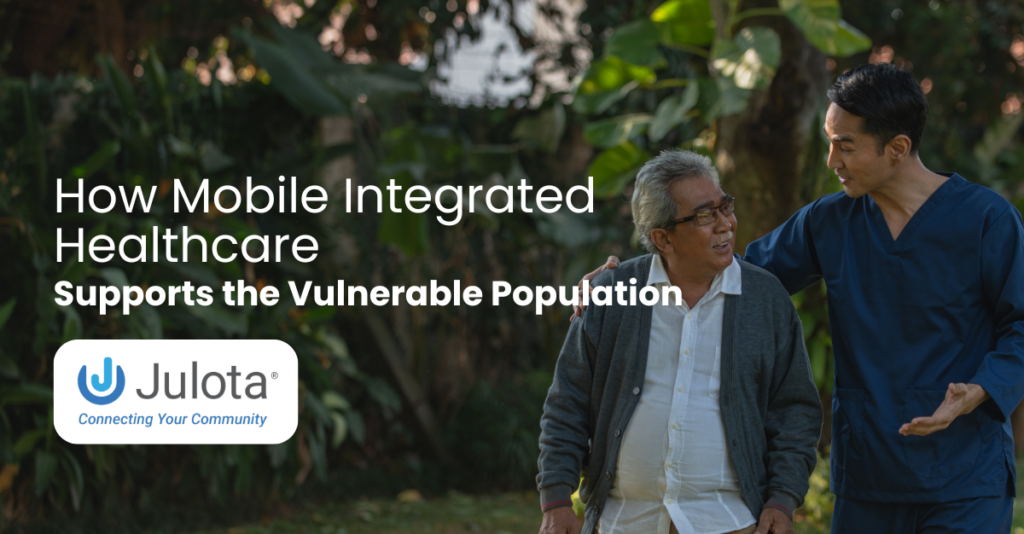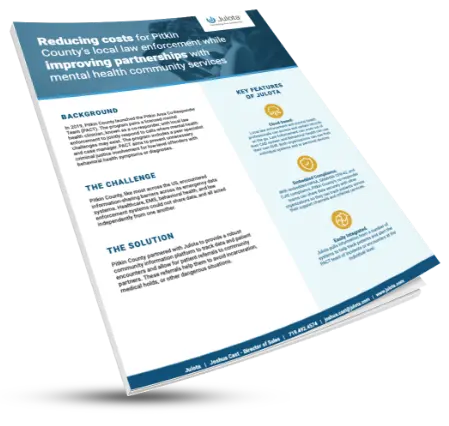Helping vulnerable populations achieve safer, healthier lives isn’t just a nice thing to do; it actively improves your community by reducing wasted resources and raising the quality of life for everyone.
Mobile integrated healthcare (MIH) supports vulnerable populations by actively meeting their needs. MIH doesn’t wait for vulnerable and disadvantaged people to reach out to them; they recognize that someone is vulnerable because they can’t. MIH offers many programs, including those for homeless people, those struggling with addiction, and long-term diseases.

Can Mobile Integrated Healthcare Community Paramedicine Help Vulnerable Populations?
The vulnerable are those who don’t have the same ability or access to the care that many people take for granted. Part of Mobile Integrated Healthcare’s mission is to fill in the gaps in care where people can slip through.
Not only does this lead to a fairer and equitable system, but it also leads to a happier and healthier community. When certain vulnerable patient groups go unnoticed, it doesn’t just hurt them – it strains the entire system.
Here are some of the most common vulnerable populations that MIH helps:
- Mobile Integrated Healthcare Helps Us Recognize Who the Vulnerable Are
- Mobile Integrated Healthcare Helps Vulnerable People with Chronic Diseases
- Those With Unstable Housing or Homelessness
- Those Who Struggle to Drive Navigate Their Homes
- Those Who Struggle with Severe Substance Addiction
- Those Who Have Mental Health Struggles
As you’ll see, these aren’t one-dimensional issues. Let’s address some specifics and nuances.
Mobile Integrated Healthcare Helps Communities Recognize Truly Vulnerable Populations
One of the biggest challenges in developing a plan to help the vulnerable is to answer the question: Who are the vulnerable in your community? We all might know who these vulnerable people are within a community.
However, healthcare (at least good healthcare) tries not to deal in generalities. Instead, good healthcare tries to do the most good for the most people, which requires good data.
That’s where MIH comes into play. Mobile integrated healthcare can dive deep into the community’s data to find the most vulnerable patients.
For example, MIH teams can look at past 911 call data to find clues about where the most vulnerable patients are. In looking at this data, they may find that there are a lot of homeless people within the community, or they may see that they responded to a higher-than-average number of falls.
After they’ve received the data, they can then make a decision on where to direct their care. This detailed health needs assessment process ensures that care for the vulnerable is based on evidence and data, not the whims of those who may not fully understand the issues.
Key point: Recognizing the vulnerable is key to helping them. Though this may seem obvious, it should not be overlooked.
Mobile Integrated Healthcare Helps Vulnerable People with Chronic Diseases
Chronic diseases are complex in the most fortunate of society–– to the vulnerable, a chronic disease is often deadly. The difference between a chronic disease and a terminal disease can often be the ability to receive regular care.
Mobile Integrated Healthcare supports the vulnerable populations struggling with chronic conditions by extending a helping hand to meet them where they are. How does this happen?
How Mobile Integrated Healthcare Helps: First, Mobile Integrated Healthcare Professionals (such as community paramedics) will enroll those patients who may not have easy access to traditional care. For example, if an older patient has poor eyesight and cannot drive, they may need care to come to them.
Also, some people do not have a strong social network of friends and family who can assist them with attending their appointments or staying current with their medications. Community paramedics can visit these patients regularly and ensure they have what they need.
The goal is to ease the strain on the patient and the system. If these vulnerable patients with chronic diseases do not receive regular care, they will often turn to the lowest common denominator: the ER.
While ERs are always there as a last resort, it would be much better for the patient and the community if the patient could receive regular preventive care.
Mobile Integrated Healthcare Helps Vulnerable People with Unstable Housing or Homelessness
People who find themselves homeless have several struggles. For one, they are often more at risk for infection. For two, as they try to find a safe place to sleep, they usually can’t worry about certain health conditions.
Mobile integrated healthcare isn’t just a clinical movement; MIH seeks to look at healthcare more holistically. For this reason, MIH teams often have social workers and mental health professionals ready to assist.
With a diverse and highly trained team, MIH is poised to improve the lives of people experiencing homelessness.
How Mobile Integrated Healthcare Helps: When MIH teams respond to a homeless person, they try to look at the situation from a broader perspective. Instead of scooping them up, driving them to the ER, and then repeating the process (with no results), they try to look at the root issue.
Does the person need mental health care? Do they need more resources to find stable housing and/or a job? These are all questions that the MIH team tries to answer, giving a homeless person the best shot at improving their lives and maintaining their health.
Now let’s talk about how MIH helps people vulnerable to falls and trips.
Mobile Integrated Healthcare Helps Vulnerable People Who Struggle to Drive Navigate Their Homes
Many of us take for granted the ability to stand, use the bathroom, and walk down a small flight of stairs. However, for many people, these simple tasks can be significant obstacles. Another thing many people don’t realize is that, for many vulnerable populations, a simple trip and fall can be deadly.
A broken hip or fractured femur is incredibly hard for people to come back from, particularly when they are already dealing with chronic disease.
How Mobile Integrated Healthcare Helps: MIH teams can assist vulnerable people with mobility and personal navigation in many ways. For one, they can educate these patients on staying safe in their homes and point out dangers. They can also recommend environmental changes (rails, ramps, etc.).
Finally, they can reduce the need for these patients to travel unnecessarily by bringing the care directly to their homes.
Mobile Integrated Healthcare Helps Vulnerable People Who Struggle with Severe Substance Addiction
We all know someone who has struggled with substance abuse. Unfortunately, substance addiction impacts the patient and their families and can often be isolating. These people are in incredibly vulnerable situations, and usually struggle to find help independently.
How Mobile Integrated Healthcare Helps: A community paramedic program can directly impact the lives of those gripped by addiction. First, they identify these patients. Next, they determine where they are on their recovery journey: Do they need immediate emergency care? Have they recently relapsed? Is their mental health getting in the way of recovery?
Finally, once the MIH team has determined what these patients need, they can dispatch specialized teams directly to the patients’ homes.
Mobile Integrated Healthcare Helps: Those Who Struggle with Severe Substance Addiction
Mental health struggles are often a quiet killer. Those struggling with clinical depression and anxiety are vulnerable to other diseases. Not only that, but when someone is having a tough time with their psychological well-being, they usually struggle to follow a detailed plan to maintain their physical well-being.
In addition to this, within the last decade, many have realized the negative side of unnecessary police intervention for patients in a mental health crisis.
How Mobile Integrated Healthcare Helps: One of the arms of MIH is the creation of teams for mental health response. These units are often comprised of paramedics and mental health professionals. The idea is to have a resource that is specifically trained to deal with a mental health crisis, and to funnel these calls away from law enforcement intervention when possible.
Conclusion: Mobile Integrated Healthcare Can Drastically Improve the Lives of Vulnerable Populations
It’s in everyone’s interest to support the vulnerable patient populations within any healthcare system. You can’t have a strong healthcare network when entire groups are being forgotten. Mobile Integrated Healthcare is a proven system that seeks to reduce overall healthcare costs while directly improving the lives of the most vulnerable.
Mobile Integrated Healthcare teams go directly to patient homes and help people manage chronic diseases, reduced mobility, addictions, and mental health struggles. These are just a few examples of the many vulnerable patient groups assisted by MIH. There are many other vulnerable groups, such as at-risk newborns, rural communities, and underserved urban areas, that can benefit from MIH.
Contact Julota if you’re interested in using their tools to transform your Mobile Integrated Healthcare teams to better serve vulnerable populations and to improve the lives of everyone in your community. A representative would happily assist, answer any questions, and provide a hassle-free demonstration.




